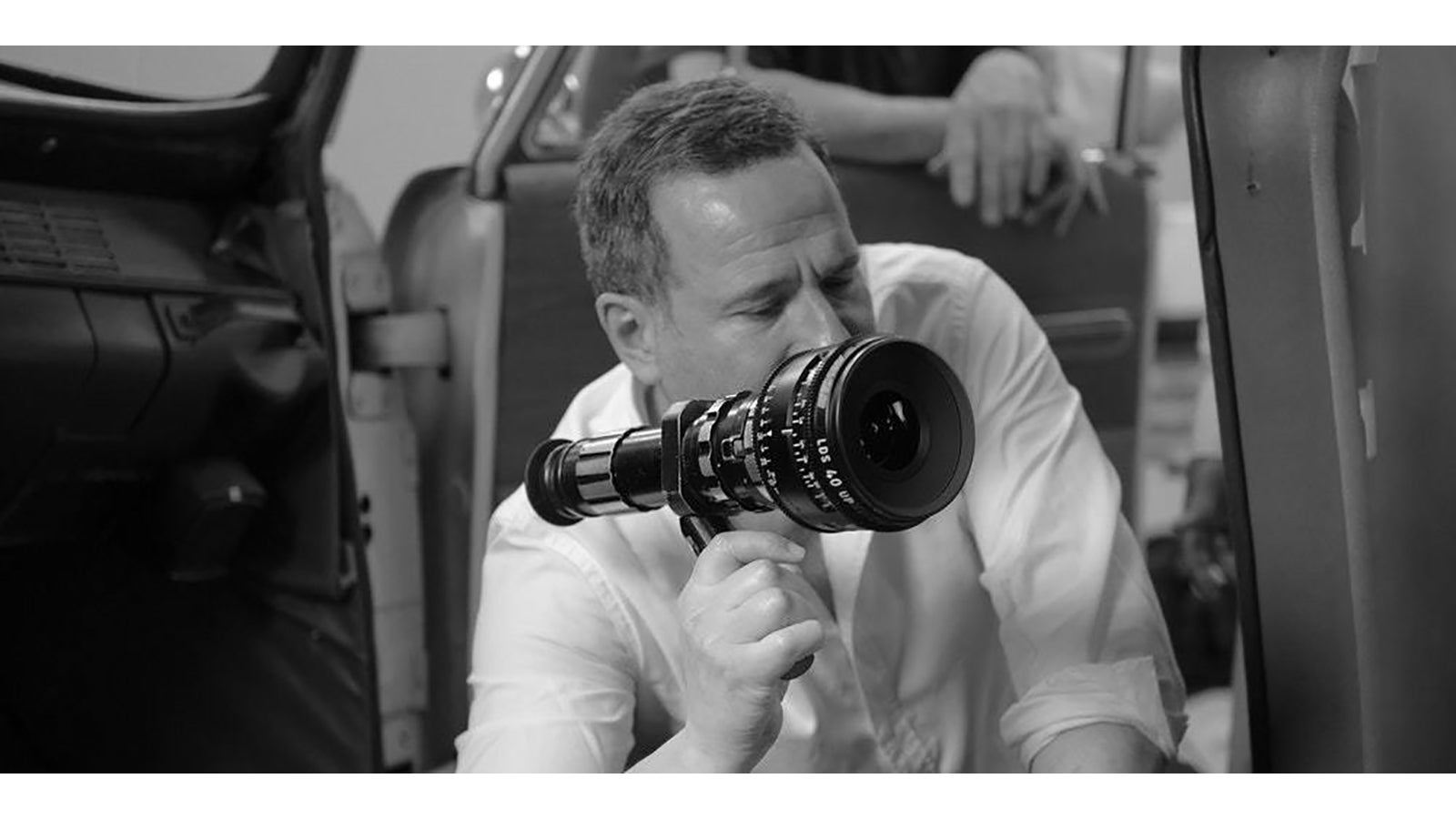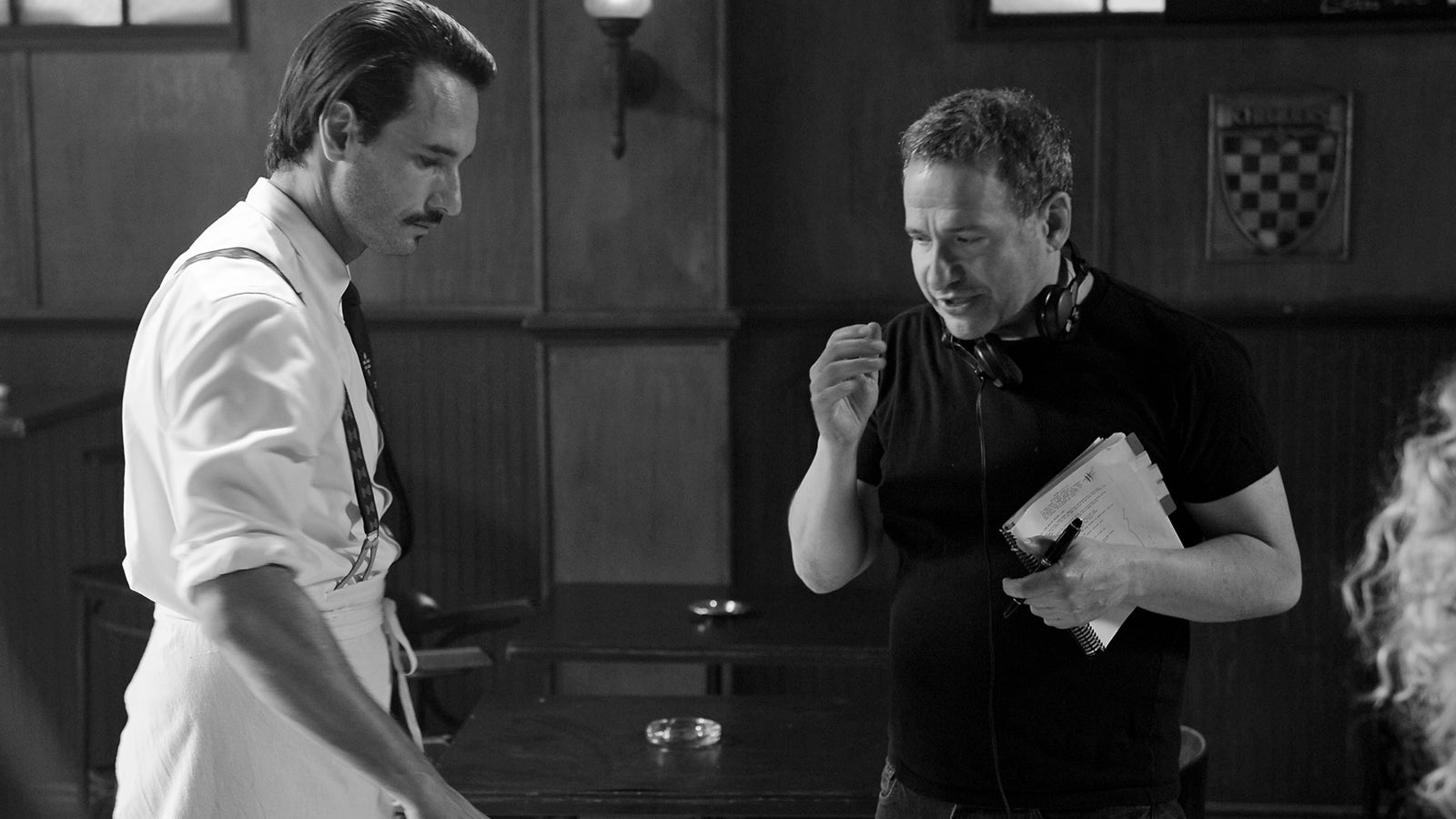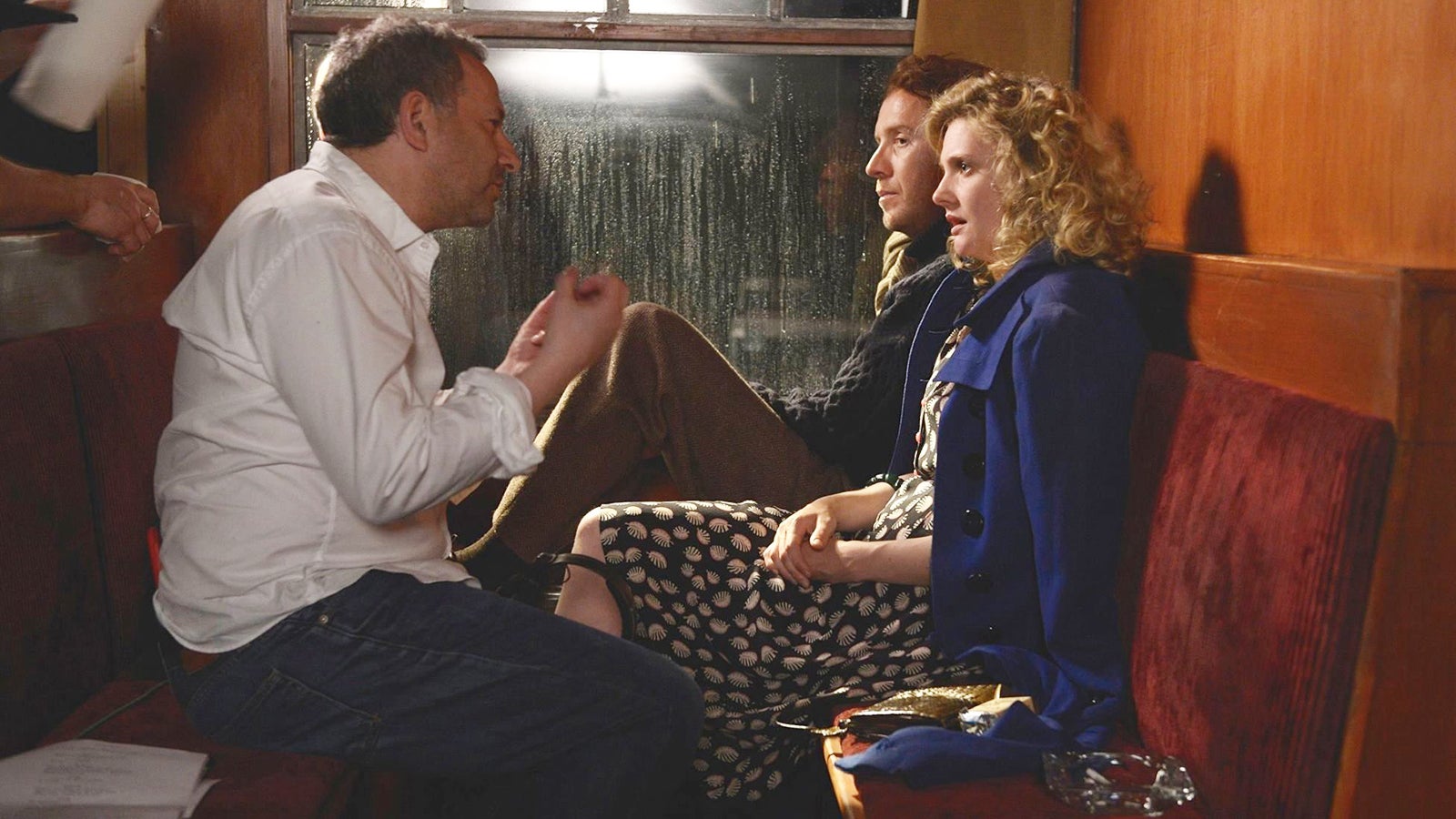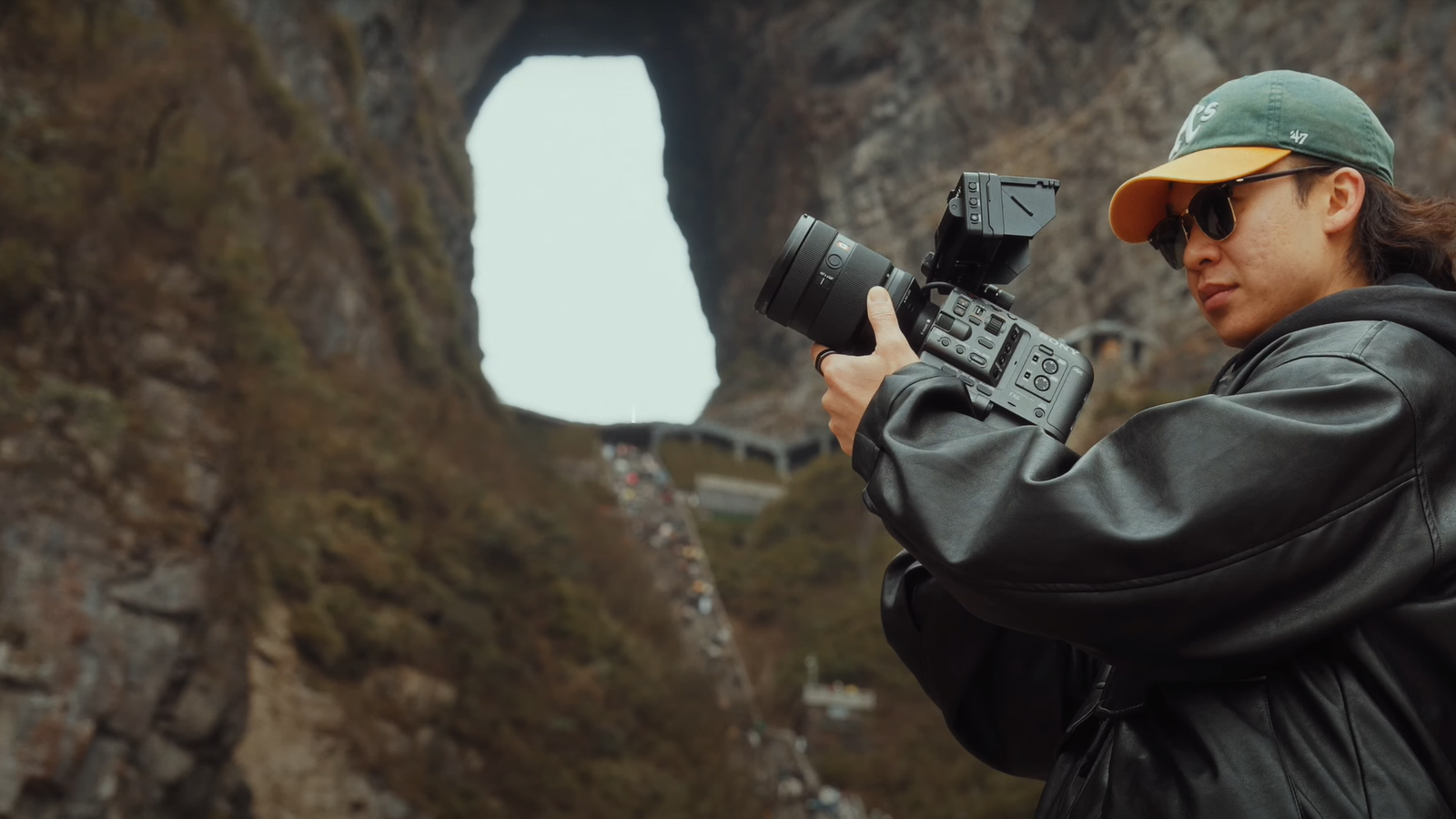
10-20-2020 - Case Study
A Film Director's View of the Cinematographer – Part 2 - Collaboration, Intuition, Oners and the Greater Good
By:
I was a cinematographer before I became a director. Although others have done this, it is still a relatively rare transition. It provides me with unique insights into a director's thinking about the cinematographer. I would like to impart those insights here. There are four things in particular I think every cinematographer should know about how a director thinks.

Bernstein reviewing a camera angle on the set of "Last Call"
3. Directors are surrounded by assassins.
Well, maybe they are, and maybe they aren't, but they certainly feel like they are a lot of the time. A director will make thousands of decisions each day. This isn't an exaggeration; it's been documented. Some decisions will be popular, some won't be popular, and some will seem to make no sense to those not capable of contextualizing the director’s thinking in relation to potential audiences, producers, studios, and the possible caprice of individual actors. But a director has a limited amount of time to explain their thinking to the crew, and sometimes it's not wise nor politic to provide an explanation. This means the crew has to draw their own, sometimes unkind, conclusions about why the director is doing what they are doing.
As the bridge between the director and the crew, it is one of the obligations of the cinematographer to act as an ambassador. Though the director's intentions aren't always manifest, it's important for the crew to understand that there is a plan. If there isn't a plan, I believe the cinematographer should step up and work with the assistant-director on developing a plan that serves the director's vision, however vague that vision may be. One way this can be done is by explaining to the crew at the beginning of each day what the director hopes to achieve. If there is a storyboard, to actually have it on display on set is useful. A shot list can also be valuable. If the crew knows what the shots are and why the shots are important, then all the members of the unit can make decisions predicated on those ambitions and relative values. Good directors can provide this same information, but when they are distracted or inexperienced, I think it is up to the DP to step in and provide a direction for the crew's labours. I can tell you as a director I find it hugely reassuring to see a cinematographer and a crew who are proactive and anticipating my requirements rather than waiting for specific instruction. Even if they are wrong, it is easier for me to redirect energies than to solicit them.
Directors have other obstacles. One regular issue is time and schedule. If a director falls behind, their film is in creative jeopardy. Money is finite, and that means assigned shooting days are finite. Rarely will producers agree to add shooting days, as that is very expensive. Often the solution to falling behind is eliminating shots and scenes. That can save the schedule and the budget but compromise the film. The person who generally knows best how long a sequence will take to set up, light, and shoot is the cinematographer. They also control how quickly those jobs can be completed. This can be dangerous wisdom. When the clock is ticking, and a cinematographer makes a pronouncement that a sequence planned by a director is going to take many hours, and many hours are not available, panic follows.
I believe that a cinematographer should be honest in their assessment, but at the same time, it is essential that they understand the director's aspirations. When there is not enough time available, the cinematographer should see if there is some alternative approach that will allow the director to get what they want without using overtime or dropping key shots. Speaking as a director and former cinematographer, I believe it is irresponsible for a cinematographer to see themselves only as a technician. The problem of limited time is not only the director's problem. Having to compromise a shot or sequence is as much a failure by the cinematographer as it is the director.

Bernstein directing Helen Hunt on the set of "Decoding Annie Parker"
What I used to do as a cinematographer, and just as I suggested in pre-production planning in Part 1 (and what I covet as a director), is the offering up of various solutions when things come unstuck, with an explanation of the implications of choosing each one. For example, when a producer is armed with a shot list and when a production is running behind, that producer might suggest combining individual shots into one long complex shot. It seems an obvious solution, but in my experience, it's catastrophic. What I would explain to a director presented with this suggestion is that if you're doing an all-in-one shot, a oner, all parts of it have to be perfect as you won't have any cuts to cover mistakes. What I am trying to get the director to understand is that it's much harder to perfectly execute a four-minute sequence than it is to break that same scene into smaller component parts. So though six shots look more time consuming than one complex shot, in fact, six simple shots can be executed more quickly. They also make the film better by offering greater flexibility in the cutting room.
It is the DP who has to deliver information like this to the director. Sometimes DPs are tempted to follow another course. Cinematographers are employed based in part on the quality of their past work, so it's natural they want to create the most compelling visual images they can in every circumstance; their careers depend on it. But they should try and remember that sometimes good enough is good enough. If the story can be told, and the image they create can still be emotive, but it can be simple and quick, if time is an issue, that choice should be offered to the director. It might not be elegant, but it might do all the director needs. It takes a highly evolved DP to be willing to give up a nice shot in the service of the greater good. It makes the subsequent showreel less spectacular, but it might save the film, and ultimately the abiding moral obligation of the cinematographer is to the film, not to their reel.
Sometimes DP’s have to follow a different course. If a wide shot provides big "production value" which makes the film better, that option has also to be presented to the director. It should be explained that it will take time and a lot of technical resources, but if the DP feels it makes the film better, they should say so.
Cinematographers can sometimes manipulate directors. I have seen it from both sides. When a cinematographer doesn't want to do a shot, they know if they say it is complicated and expensive, they might get the producers to stop it. This is not a good professional practice. It is the job of the DP to make my job as a director easier, not harder, and find solutions, not create obstacles.

Steven Bernstein directing Rodrigo Santoro on the set of "Last Call"
There are always pressures on directors from producers and production managers to not fall behind. Producers and production managers are not directors, and though they may like the script and understand a spreadsheet, they are not always qualified to make a decision about the importance of an individual shot. Sometimes as a director, I have to insist that though time is against me, a particular shot is essential. It is virtually impossible to always explain why a shot is important. Verbal language describing visual language is inadequate. Producers will often push back and it can become fraught. But if I am always willing to compromise my vision, then I am not a very good director. So, I also push back. This is not easy. It is hard for the director to push back against producers by themselves. This is where the alliance with the cinematographer is essential. If a cinematographer says to the producers that they understand why the director needs the shot they are requesting, producers listen. Better, if the DP can find a way to do it more quickly and for less money, then the director gets what they want without drama. Of course, sometimes expenditures are necessary and the DP should defend that as well. That's harder, but the truth is the truth. Compromise isn't always the right way forward, though irresponsible spending is also never correct.
A film's complex politics absorb much of the director's attention. Those politics will inevitably also hold the cinematographer in its not so warm embrace. I have worked on many films as a cinematographer when production managers have tried to enlist me as their ally against the director. They would ask me if sequences "really" had to be shot the way the director suggested, or whether we needed "so many extras", or whether an expensive location was really necessary. These are all poisoned chalices from which cinematographers should not drink. Again, it is the professional responsibility of the cinematographer to stay on time and on budget, but that should always be predicated by first realizing the director's vision. It is tempting, for example, to try to please the production office by cutting back crewing levels. However, I must tell you as a director, nothing is more frustrating than having to drop shots because the crew is slow because we don't have enough people. My greatest frustration is with cinematographers who explain to me they were trying to please production by reducing the crew size. They must be aware it will force me to drop shots to finish the day on time, yet they do it anyway. I think the right way to play this is for a cinematographer to say truthfully to the director in the pre-production that they are under pressure to reduce crew levels and that this might have an impact subsequently on the shooting. Cinematographers, in a sense, have two masters, but they should not let themselves be confused; ultimately, they have to make the best possible film. That might mean they have to push back with production to get what they need and more importantly, what the director needs.

Bernstein directing Romola Garai on the set of "Last Call"
4. Directors know what they want; they don't always know what they need.
For my new film, “Last Call,” which stars John Malkovich, Rhys Ifans, Tony Hale, Rodrigo Santoro, Zosia Mamet and Romola Garai, I was very lucky to have a hugely positive response to my screenplay with talent agencies and actors. Were it not for this terrible pandemic it would be in theatres now. It's a very good film. However, when we finished shooting, and I did the first assembly, the film had lots of great sequences but didn't hold together as a whole. I had planned the film in the most minute of detail and had diagrammed every sequence complete with notes for every department and some storyboards. Nothing was left to chance. Still, the cut wasn't working.
I was very fortunate that my producer Richard Gladstein (who produced “Pulp Fiction,” “Cider House Rules,” “Reservoir Dogs,” etc.), connected me with the brilliant editor Chris Gill (who previously edited “28 Weeks Later” for Danny Boyle). Chris was in the UK, and I sent the film to him with over a hundred pages of notes. Fortunately for me, Chris saw the rough cut and loved the film but ignored my notes. I was shocked and offended. I needn't have been. He asked for all the dailies and began a recut of the film. A wholly new film emerged. The film appeared as a work in progress at the Rio film festival and was called Oscar-worthy by all four of the major Brazilian newspapers.
Still as a work in progress, it went to the Tallinn Film Festival, where it won the Best Actor award for Rhys Ifans. Chris Gill had made the film much better. Though many of my notes came into play when I went to England and worked with him directly, before the film went to those festivals, he still had discovered ideas in the dailies which I hadn't considered. This is significant. Had I only shot what I had meticulously planned, the opportunity for the considerable improvement in the editing room would not have been possible. We shot most of the film with multiple cameras, and even when the hero cameras were getting the shots that I had planned, my cinematographer Antal Steinbach, made sure that we were getting many other reaction shots, cutaways, close-ups from different angles, and additional wide shots. These extra shots turned out not to be extra. They were essential. This is the additional obligation of the cinematographer; give the director and editor many more shots than they request. Particularly with young directors who don't always understand that when the plan doesn't work in the cutting room, you need other options.

Director Deon Taylor on the set of the Screen Gems film "Black and Blue"
I have a specific methodology as a director, whereby I encourage a lot of improvisation from actors. Though we eventually work our way back to the script as I wrote it, I l feel it helps actors to explore the complexities of their characters through improv. There is a truth in intuition you can't always find by planning or thought. I feel the same thing about blocking a scene for camera. Usually, we put down marks so actors land at particular spots, and we can get the lighting and focus right. But when I was the cinematographer on the Oscar-winning “Monster,” I hit on the idea of facilitating Charlize's performance by telling her she could go where ever she liked. She loved the notion, as did the director, Patty Jenkins. My key-lights would move with her. The focus-puller was on the side of the set and could judge the focus distance as she moved. It wasn't easy, but it worked. On "Last Call,” as director, I employed the same strategy, this time with many cameras. It was wild, and hard work for the crew, but the performances were breathtaking, I think, in part because of this method. We didn't always know the exact shot we would end up with, but with so many cameras working we got a lot of great material. The pure intuition of it all made it magical. Now I can't imagine any other way of shooting or directing.
Having been both a cinematographer and a director, I think I understand what it takes to make a film and I know what a director wants of a cinematographer. First, a director wants a genuine collaboration. The cinematographer must be completely loyal to that director even if they don't always understand the director's vision. They must act as good ambassadors for the director to the crew and act as an example to that crew. The cinematographer should understand the complex political world the director inhabits and support them creatively and practically. Most of all, the cinematographer should provide the director not only with what they want but what they need.
Click here to read Part 1 of this two-part article.
About the author:
Steven Bernstein, DGA, ASC, WGA is an ASC outstanding achievement nominee for the TV series Magic City. He shot the Oscar winning film “Monster,” “Kicking and Screaming,” directed by Noah Baumbach, “White Chicks” and some 50 other features and television shows. The second film he wrote and directed, “Last Call,” stars John Malkovich, Rhys Ifans, Rodrigo Santoro, Zosia Mamet, Tony Hale, Romola Garai and Phil Ettinger, is scheduled for release later this year.
Steven can be followed at Stevenbernsteindirectorwriter on instagram where he regularly posts short insights and illustrations about filmmaking.





